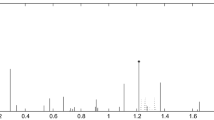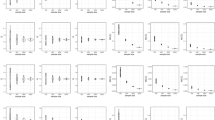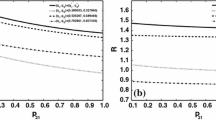Abstract
In this paper, we address the aggregation of dependent stop loss reinsurance risks where the dependence among the ceding insurer(s) risks is governed by the Sarmanov distribution and each individual risk belongs to the class of Erlang mixtures. We investigate the effects of the ceding insurer(s) risk dependencies on the reinsurer risk profile by deriving a closed formula for the distribution function of the aggregated stop loss reinsurance risk. Furthermore, diversification effects from aggregating reinsurance risks are examined by deriving a closed expression for the risk capital needed for the whole portfolio of the reinsurer and also the allocated risk capital for each business unit under the TVaR capital allocation principle. Moreover, given the risk capital that the reinsurer holds, we express the default probability of the reinsurer analytically. In case the reinsurer is in default, we determine analytical expressions for the amount of the aggregate reinsured unpaid losses and the unpaid losses of each reinsured line of business of the ceding insurer(s). These results are illustrated by numerical examples.
Similar content being viewed by others
References
Abdallah A, Boucher JP, Cossette H, Trufin J (2015) Sarmanov family of bivariate distributions for multivariate loss reserving analysis. UQAM
Badescu A, Gong L, Lin XS, Tang D (2015) Modeling correlated frequencies with applications in operational risk management. J Operat Risk 10(1):1–43
Cossette H, Côté MP, Marceau E, Moutanabbir K (2013) Multivariate distribution defined with Farlie-Gumbel-Morgenstern copula and mixed Erlang marginals: Aggregation and capital allocation. Insur Math Econ 52:560–572
Cossette H, Mailhot M, Marceau E (2012) TVaR-based capital allocation for multivariate compound distributions with positive continuous claim amounts. Insur Math Econ 50(2):247–256
Cummins JD (2000) Allocation of capital in the insurance industry. Risk Manage Insurance Rev 3(1):7–27
Denuit M, Dhaene J, Goovaerts M, Kaas R (2005) Actuarial theory for dependent risks: measures, orders and models. Wiley, New York
Dhaene J, Tsanakas A, Valdez EA, Vanduffel S (2012) Optimal capital allocation principles. J Risk Insurance 79(1):1–28
Dickson DCM (2008) Some explicit solutions for the joint density of the time of ruin and the deficit at ruin. ASTIN Bull 38(1):259–276
Dickson DCM, Willmot GE (2005) The density of the time to ruin in the classical Poisson risk model. ASTIN Bull 35(1):45–60
Hashorva E, Ratovomirija G (2015) On Sarmanov mixed Erlang risks in insurance applications. ASTIN Bull 45(1):175–205
Hernández-Bastida A, Fernández-Sánchez MP (2012) A Sarmanov family with beta and gamma marginal distributions: an application to the Bayes premium in a collective risk model. Stat Methods Appl 21(4):391–409
Klugman SA, Panjer HH, Willmot GE (2008) Loss models: from data to decisions. Wiley Series in Probability and Statistics, third Edition, Wiley
Lee MLT (1996) Properties and applications of the Sarmanov family of bivariate distributions. Commun Stat Theory Methods 25(6):1207–1222
Lee SCK, Lin XS (2010) Modeling and evaluating insurance losses via mixtures of Erlang distributions. N Am Actuarial J 14(1):107–130
Lee SCK, Lin XS (2012) Modeling dependent risks with multivariate Erlang mixtures. ASTIN Bull 42(1):153–180
Mari DD, Kotz S (2001) Correlation and dependence. World Scientific
McNeil AJ, Frey R, Embrechts P (2005) Quantitative risk management: Concepts. Princeton Series in Finance, Princeton University Press, Princeton, Techniques and Tools
Meyers GG, Klinker FL, Lalonde DA (2003) The aggregation and correlation of reinsurance exposure. Casualty Actuarial Society Forum
Myers SC, Read JA (2001) Capital allocation for insurance companies. J Risk Insurance, 545–580
Sarabia JM, Gómez-Déniz E (2011) Multivariate Poisson-Beta Distributions with applications. Commun Stat Theory Methods 40(6):1093–1108
Sarmanov OV (1966) Generalized normal correlation and two-dimensional Fréchet classes. Doklady Akademii Nauk SSSR 168:32–35
Tang A, Valdez EA (2006) Economic capital and the aggregation of risks using copulas. In: Proceedings of the 28th International Congress of Actuaries, Paris France
Tasche D (2004) Allocating portfolio economic capital to sub-portfolios. A Practitioner’s Guide, Risk Books, Economic Capital, pp 275–302
Tasche, D. (2005). Measuring sectoral diversification in an asymptotic multi-factor framework. arXiv preprint physics/0505142
Verbelen R, Antonio K, Gong L, Badescu A, Lin XS (2014) Fitting mixtures of Erlangs to censored and truncated data using the EM algorithm, Working paper
Vernic R (2014) On the distribution of a sum of Sarmanov distributed random variables. J Theor Probab 1–25
Willmot GE, Lin XS (2011) Risk modeling with the mixed Erlang distribution. Appl Stoch Models Bus Indus 27(1):1524–1904
Willmot GE, Woo JK (2007) On the class of Erlang mixtures with risk theoretic applications. N Am Actuarial J 11(2):99–115
Willmot GE, Woo JK (2015) On some properties of a class of multivariate Erlang mixtures with insurance applications. ASTIN Bull 45(1):151–173
Yang Y, Hashorva E (2013) Extremes and products of multivariate AC-product risks. Insur Math Econ 52(2):312–319
Yang Y, Wang Y (2013) Tail behavior of the product of two dependent random variables with applications to risk theory. Extremes 16(1):55–74
Acknowledgments
I would like to thank to referees for numerous suggestions which improved this paper significantly. Partial financial support received from the project RARE—318984 (an FP7 Marie Curie IRSES Fellowship) and Vaudoise Assurances is kindly acknowledged.
Author information
Authors and Affiliations
Corresponding author
Appendices
Appendix 1: Properties of mixed Erlang distribution
Lemma 6.1
For a deductible \(d >0\), if \(X \sim ME(\beta , \underline{V})\) then the df of \(Y:=(X-d)_+\) is given by
where
with
Lemma 6.2
Let \(X_1\) and \(X_2\) be two independent risks such that \(X_i\sim ME(\beta ,\underline{Q}_i), i=1,2\). If \(Y_i=(X_i-d_i)_+\) with \(d_i>0, i=1,2\) then \(R_2= Y_1+ Y_2\) has a df
where
Remark 6.3
Given the tractable expression of the df of \(R_2\), its VaR at a confidence level \(p \in (0,1)\) is the solution of
which can be solved numerically. In addition, the TVaR of \(R_2\) at a confidence level \(p \in (0, 1)\) is given by (set \(x_p:=VaR_{R_2} (p)\))
where
Proof
Since \(Y_1\) and \(Y_2\) are independent risks which have mixed distribution, the df of \(R_2\) can also be expressed as a df of a mixed distribution which depends on the value of s as follows:
-
the discrete part of \(F_{R_2}\) is obtained for \(s=0\), specifically we have
$$\begin{aligned} F_{R_2}(0) = \mathbb {P}(Y_1 + Y_2 \leqslant 0) = \mathbb {P}(Y_1 + Y_2 = 0) = \mathbb {P}(Y_1=0, Y_2 = 0) = F_{X_1}(d_1) F_{X_2}(d_2), \end{aligned}$$(6.4) -
for \(s>0\) the continious part of \(F_{R_2}\) is given by
$$\begin{aligned} F_{R_2}(s) &= \mathbb {P}(Y_1 + Y_2 \leqslant s ) \nonumber \\ &= \mathbb {P}( Y_1 + Y_2 \leqslant s, Y_1 = 0, 0< Y_2 \leqslant s) + \mathbb {P}( Y_1 + Y_2 \leqslant s, 0< Y_1 \leqslant s, Y_2 = 0) \nonumber \\&\quad+ \mathbb {P}(Y_1 + Y_2 \leqslant s , 0< Y_1 \leqslant s, 0< Y_2 \leqslant s) \nonumber \\&= \mathbb {P}( Y_1 = 0, 0 <Y_2 \leqslant s) + \mathbb {P}(0 < Y_1 \leqslant s, Y_2 = 0) + \mathbb {P}( Y_1 + Y_2 \leqslant s , 0< Y_1 \leqslant s, 0< Y_2 \leqslant s) \nonumber \\ & = F_{X_1}(d_1) F_{X_2}(s+d_2) + F_{X_2}(d_2) F_{X_1}(s+d_1) + \int _0^s F_{X_1}( s- u + d_1) f_{X_2}(u+ d_2) du. \end{aligned}$$(6.5)Let \(F_{{T_{2,k}}}(s) : = \int _0^s F_{X_1}( s- u + d_1) f_{X_2}(u+ d_2) du\), by Lemma 6.1 this can be written as
$$\begin{aligned} F_{{T_{2,k}}}(s) = \sum _ {k=0}^{\infty } \sum _ {j=0}^{\infty } \Delta _k(d_1,\beta _1,\underline{Q}_1) \Delta _j(d_2,\beta _2,\underline{Q}_2) \int _0^s W_{k+1}(s- u,\beta ) w_{j+1}(u,\beta ) du. \end{aligned}$$(6.6)
It can be seen that \(\int _0^s W_{k+1}(s- u,\beta ) w_{j+1}(u,\beta ) du\) is a convolution of two independent Erlang risks with a common scale parameter \(\beta\), which is again an Erlang risk with shape parameter \(k+j+2\) and scale parameter \(\beta\). Thus combining (6.4), (6.5) and (6.6) the claim follows easily. \(\square\)
Lemma 6.4
Let \(X \sim ME(\beta , \underline{V})\) with pdf \(f(x,\beta ,\underline{V})\), if g is some positive function such that \(\mathbb {E}\left\{ g(X)\right\} <\infty\), then \(c(x,\beta ,\underline{V})=\frac{g(x)f(x,\beta ,\underline{V})}{\mathbb {E}\left\{ g(X)\right\} }\) is again a pdf of mixed Erlang distribution with scale parameter \(Z(\beta )\) and mixing weights \(\underline{\Theta }(\underline{V})=(\theta _1,\theta _2,\ldots )\), with
where
-
\(Z(\beta )=2 \beta\) and \(\theta _k = \frac{1}{2^{k-1}} \sum _{j=1}^k \begin{pmatrix} k-1\\ j-1 \end{pmatrix} q_j \sum _{l=k-j+1}^\infty q_l ,\) for \(g(x)=2\overline{F}(x)\),
-
\(Z(\beta )= \beta\) and
$$\begin{aligned} \theta _k= \left\{ \begin{array}{lll} 0 &{} \text{ for } \,\, k \leqslant t , \\ \frac{q_{k-t}\frac{\Gamma (k)}{\Gamma (k-t)}}{\sum _{j=1}^\infty q_j\frac{\Gamma (j+t)}{\Gamma (j)} } &{}\text{ for } \,\, k > t, \end{array} \right. \end{aligned}$$for \(g(x)=x^t\) with \(t \in \mathbb {R}\),
-
\(Z(\beta )= \beta + t\) and \(\theta _k = \frac{q_k \overline{\beta }^k}{\sum _{j=1}^\infty q_j\overline{\beta }^j }\) with \(\overline{\beta } =\frac{\beta }{\beta + t} ,\) for \(g(x)=e^{-tx}\) with \(t \in \mathbb {N}\).
Proof
We have
For \(g(x)= x^t\) one can write (6.7) as follows
with
For \(g(x)= e^{-tx}\), (6.7) can be expressed as follows (set \(\overline{\beta } := \frac{\beta }{\beta +t}\))
For \(g(x)=2\overline{F}(x)\), see [3] for the proof. The results presented in the next two lemmas can be found in Section 2.2 of [28] and Section 7.2 of [14], respectively. \(\square\)
Lemma 6.5
If \(X \sim ME(\beta _1,\underline{V})\), then for any positive constant \(\beta _2 \ge \beta _1\) we have
where
Lemma 6.6
Let \(X_1,X_2\) be two independent rv such that \(X_i\sim ME(\beta , \underline{Q}_i) ,i=1,2\), then \(S_2=X_1+X_2\sim ME(\beta , \underline{\Pi }\{\underline{Q}_1, \underline{Q}_2\})\) with
Remark 6.7
According to Cossette et al. [4] (Remark 2.1), the results in Lemma 6.6 can be extended to \(S_n= \sum _{i=1}^n X_i\), provided that \(X_1,\ldots ,X_n\) are independent, \(X_i\sim ME(\beta , \underline{Q}_i)\) for \(i=1,\ldots ,n\). Specifically, \(S_n \sim ME(\beta , \underline{\Pi }\{\underline{Q}_1,\ldots , \underline{Q}_n\})\) where the individual mixing probabilities can be evaluated iteratively as follows
Appendix 2: Pearson’s coefficient of a bivariate Sarmanov mixed Erlang risk
Pearson’s coefficient \(\rho _{1,2}\) is one of the most commonly used dependence measures between two risks \(X_1\) and \(X_2\). In this regards, \(X_1\) and \(X_2\) are assumed to be linearly correlated. Following (2.1), we show next that when \((X_1,X_2) \sim SME(\varvec{\beta }, \underline{Q})\), the closed expressions for \(\rho _{1,2}\) depend on the dependence parameter \(\alpha _{1,2}\) and the choice of kernel functions as follows:
-
for \(\phi _i(x_i)=x_i^t - \mathbb {E}\left\{ X_i^t \right\} , t>0\)
$$\begin{aligned} \rho _{1,2}(X_1,X_2)=\frac{\alpha _{1,2} (m_{1} ^{t+1} - m_{1} ^{t} m_{1} ^{1}) (m_{2} ^{t+1} - m_{2} ^{t} m_{2} ^{1})}{\sigma _1 \sigma _2}, \end{aligned}$$where \(\sigma _i\) is the standard deviation of \(X_i\) and
$$\begin{aligned} m_i^{s} = \mathbb {E}\left\{ X_i^s \right\} = \frac{1}{\beta _i^s}\sum _{j=1}^\infty q_{i,j} \frac{(s+j-1)!}{(j-1)!} , \quad i=1,2, \ \text {with } s>0, \end{aligned}$$in particular for \(t=1\)
$$\begin{aligned} \rho _{1,2}(X_1,X_2)= \alpha _{1,2} \sigma _1 \sigma _2 , \end{aligned}$$ -
for \(\phi _i(x_i)=e^{-t x_i}- \mathbb {E}\left\{ e^{-t X_i} \right\} , t>0\)
$$\begin{aligned} \rho _{1,2}(X_1,X_2)= \frac{\alpha _{1,2} ( \eta _{1,t}-\Gamma _{1,t} ) ( \eta _{2,t}-\Gamma _{2,t} )}{\sigma _1 \sigma _2}, \end{aligned}$$where \(\eta _{i,t}=\frac{1}{\beta _i+t}\sum _ {j=1}^{\infty }j q_{i,j} \biggl ( \frac{ \beta _i }{\beta _i+t} \biggr ) ^j\) and \(\Gamma _{i,t} = m^1_i \sum _ {j=1}^{\infty } q_{i,j} \biggl ( \frac{ \beta _i }{\beta _i+t} \biggr ) ^j , i=1,2\),
-
for \(\phi _i(x_i)= 2\overline{F}_i(x_i)-1\), see [3]
$$\begin{aligned} \rho _{1,2}(X_1,X_2)= \frac{\alpha _{1,2}}{\beta _1 \beta _2 \sigma _1 \sigma _2 } \sum _{j=1}^\infty \sum _{k=1}^\infty jk (\theta _{1,j} - q_{1,j} ) (\theta _{2,k} - q_{2,k} ), \end{aligned}$$where \(\theta _{1,j}\) and \(\theta _{2,k}\) are defined in (3.1).
Rights and permissions
About this article
Cite this article
Ratovomirija, G. On mixed Erlang reinsurance risk: aggregation, capital allocation and default risk. Eur. Actuar. J. 6, 149–175 (2016). https://doi.org/10.1007/s13385-016-0124-0
Received:
Revised:
Accepted:
Published:
Issue Date:
DOI: https://doi.org/10.1007/s13385-016-0124-0




